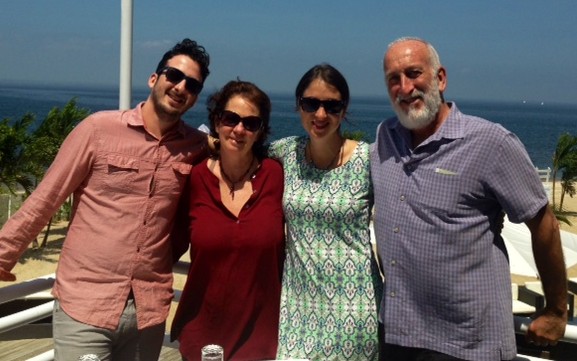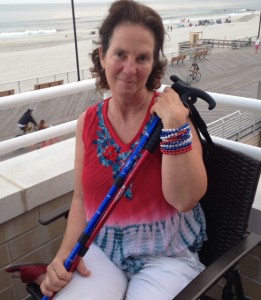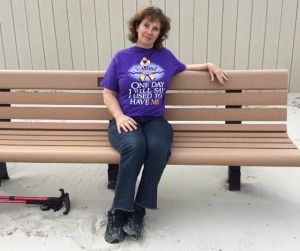Andrea Kaiser Shares Her PPMS Journey Through to Stem Cell Therapy in Exclusive Interview

The Kaiser family, from right to left: husband, Ric; their daughter, Alexandra; Andrea; and their son, Dakota.
Andrea Perry Kaiser is a woman on a mission. The Long Beach, New York, resident is soon to undergo hematopoietic stem cell transplantation (HSCT) for her multiple sclerosis (MS). Kaiser contacted Multiple Sclerosis News Today to chronicle her journey, both before and following the treatment.
She received a primary progressive multiple sclerosis (PPMS) diagnosis in 2010, at the age of 54, after almost two years of wondering what was going wrong with her body.
 “When I was approaching the age of 50 in 2006,” she said, “I attributed anything funny to peri-menopause. I would fall for no reason, [have] heart palpitations, extreme sensitivity to heat. I had bladder issues. I was told that I had a fallen pelvic floor, rectocele, cystocele. I had reconstructive surgery in 2008. I had lower back pain, and was told I needed [disk surgery]. Before jumping into surgery I wanted to explore further.”
“When I was approaching the age of 50 in 2006,” she said, “I attributed anything funny to peri-menopause. I would fall for no reason, [have] heart palpitations, extreme sensitivity to heat. I had bladder issues. I was told that I had a fallen pelvic floor, rectocele, cystocele. I had reconstructive surgery in 2008. I had lower back pain, and was told I needed [disk surgery]. Before jumping into surgery I wanted to explore further.”
She began moving toward an initial MS diagnosis when “a chiropractor told me that my gait was off. I went to a neurologist in 2009. After a slew of tests, I was told that I had MS. There is no definitive test for MS, it is more about ruling out other diseases. There were white lesions on my brain. My spinal fluid test was negative.”
Initial treatments, including steroid infusion, were not successful. Kaiser’s ability to walk and move continued to deteriorate, and beginning in 2010 she began “a slow but steady descent. I went from no outward signs to needing canes, a rolling walker and a wheelchair, depending on the distance. I mark my descent by the years. One summer I could still ride my bicycle, then I had to buy a tricycle due to balance issues.”
Her level of disability is now between 6 and 6.5 EDSS. EDSS, a measurement of multiple sclerosis disability, stands for Expanded Disability Status Scale and is commonly used in MS clinical trials and for the clinical assessment. A score of 6–6.5 means that she requires walking aids in order to get around.
“I hope to stop the progression before I end up in a wheelchair. Any improvement in my current disability would be icing on the cake,” Kaiser said.
She will travel to Jerusalem, Israel, on March 16, and begin receiving treatment at Shaare Zedek Medical Center under the care of Dr. Jacob Rowe. Kaiser has spent years researching the procedure, she said, and belongs to several online groups that have provided her with a great deal of information. She also maintains her own blog, focusing on her planned treatment.
HSCT is a common treatment for bone marrow and blood cancers, and is sometime s used to treat people with MS. The technique involves harvesting new, undeveloped blood or bone marrow (hematopoietic) cells, typically from the person affected with the disease (autologous). The goal is to remove faulty cells and replace them with new cells that will no longer cause demyelination, the principal cause of MS.
s used to treat people with MS. The technique involves harvesting new, undeveloped blood or bone marrow (hematopoietic) cells, typically from the person affected with the disease (autologous). The goal is to remove faulty cells and replace them with new cells that will no longer cause demyelination, the principal cause of MS.
Kaiser warns that HSCT has only been effective when it includes an initial chemotherapy procedure to remove faulty cells before replacing them. “There was a ’60 [Minutes]’ segment on stem cell fraud by Morley Safer. This made me very nervous,” she said. “NO CHEMO, NO CURE.”
Although it is not currently possible to modify or halt PPMS, Kaiser does take medications for specific symptoms, including Ampyra, which helps her to walk, and Mirapex for restless leg syndrome. She recently stopped taking Tecfidera because she did not feel it was helping. Kaiser also takes supplements, including 5000 U vitamin D, B12, probiotics, COQ10, and D-mannose. Special diets and a naturopathic physician were not helpful for her, however, Kaiser does incorporate physical activity into her daily routine. This includes physical therapy, yoga, water class, Feldenkrais, and weight training.
Her highest hopes, though, are that stem-cell treatment will help arrest her disease and, possibly, restore some lost abilities.
“I have spoken to women in the U.S. who have undergone HSCT,” she said. “It is very encouraging. I correspond with people from around the world who have had successful treatment. The goal is to stop the progression. If you regain any lost ability, that is icing on the cake. It does happen. I hope to stop the progression of my MS. I hope to regain lost ability. I want to take long walks, I want to dance, I hope to walk my children down the aisle when they marry, I want to help take care of any grandchildren I might have.
“I do not want to spend my life in a wheelchair. I don’t want to lose my independence.”
Kaiser is skeptical of the reasons given by professionals in the United States for not allowing HSCT. The procedure, she agreed, is “very extreme and serious.” But, she said, “MS is not a fatal disease, as cancer is, which is part of the reason doctors, in this lawsuit-happy country, won’t do it. It is not illegal, but it is not FDA approved. My attitude is: My body, my life, my choice.”
Multiple Sclerosis News Today will continue to follow Kaiser, and report on her experiences with HSCT and her progress.






